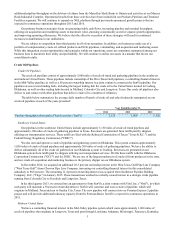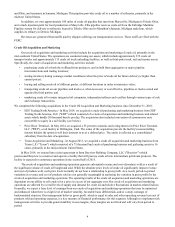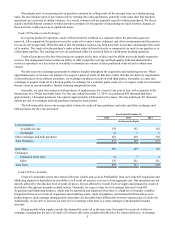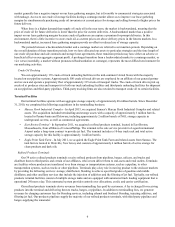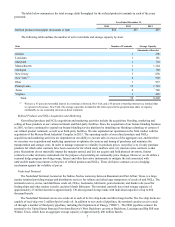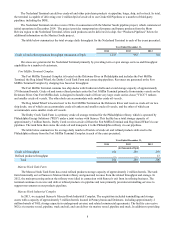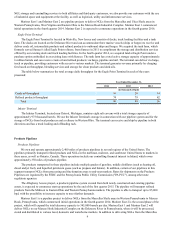Sunoco 2014 Annual Report Download - page 15
Download and view the complete annual report
Please find page 15 of the 2014 Sunoco annual report below. You can navigate through the pages in the report by either clicking on the pages listed below, or by using the keyword search tool below to find specific information within the annual report.13
Safety Regulation
A majority of our pipelines are subject to United States Department of Transportation ("DOT") regulations and to
regulations under comparable state statutes relating to the design, installation, testing, construction, operation, replacement and
management of pipeline facilities.
DOT regulations require operators of hazardous liquid interstate pipelines to develop and follow a program to assess the
integrity of all pipeline segments that could affect designated "high consequence areas," including: high population areas,
drinking water and ecological resource areas that are unusually sensitive to environmental damage from a pipeline release, and
commercially navigable waterways. We have prepared our own written Integrity Management Program, identified the line
segments that could impact high consequence areas, and completed a full assessment of these segments as prescribed by the
regulations.
We are confident that our pipeline operations are in substantial compliance with applicable DOT regulations and
comparable state requirements. However, an increase in expenditures may be needed in the future to comply with higher
industry and regulatory safety standards. Such expenditures cannot be estimated accurately at this time, but we do not believe
they would likely have a material adverse effect relative to our results of operations, financial position or expected cash flows.
Environmental Regulation
General
Our operations are often subject to complex federal, state, and local laws and regulations relating to the protection of
health and the environment, including laws and regulations which govern the handling and release of crude oil and other liquid
hydrocarbon materials, some of which are discussed below. Violations of environmental laws or regulations can result in the
imposition of significant administrative, civil and criminal fines and penalties and, in some instances, injunctions banning or
delaying certain activities. Our management believes we are in substantial compliance with applicable environmental laws and
regulations. However, these laws and regulations are subject to frequent change at the federal, state and local levels, and the
legislative and regulatory trend has been to place increasingly stringent limitations on activities that may affect the
environment.
There are also risks of accidental releases into the environment associated with our operations, such as releases of crude
oil or hazardous substances from our pipelines or storage facilities. To the extent an event is not covered by our insurance
policies, such accidental releases could subject us to substantial liabilities arising from environmental cleanup and restoration
costs, claims made by neighboring landowners and other third parties for personal injury and property damage, and fines or
penalties for any related violations of environmental laws or regulations.
Sunoco indemnifies us for 100 percent of all losses from environmental liabilities related to the assets contributed to SXL
arising prior to, and asserted within 21 years of, February 8, 2002, the date of our initial public offering ("IPO"). Sunoco's share
of liability for claims asserted thereafter will decrease by 10 percent each year through the thirtieth year following the IPO date.
For example, for a claim asserted during the twenty-third year after the closing of the IPO, Sunoco would be required to
indemnify the Partnership for 80 percent of its loss. There is no monetary cap on this indemnification from Sunoco. In addition,
this indemnification applies to the following, purchased from Sunoco subsequent to the IPO: interests in the Mesa Pipeline
System, Mid-Valley, West Texas Gulf and Inland, as well as the Eagle Point Tank Farm and various other assets. Any
remediation liabilities not covered by this indemnity will be our responsibility.
We have agreed to indemnify Sunoco and its affiliates for events and conditions associated with the operation of the
contributed assets occurring after the IPO date and for environmental and toxic tort liabilities related to these assets to the
extent Sunoco is not required to indemnify us. Total future costs for environmental remediation activities will depend upon,
among other things, the extent of impact at each site; the timing and nature of required remedial actions; the technology
available; and the determination of our liability at multi-party sites. As of December 31, 2014, all material environmental
liabilities incurred by, and known to, us are either covered by the environmental indemnification or reserved for by us in our
consolidated financial statements.
Air Emissions
Our operations are subject to the Clean Air Act, as amended, and comparable state and local statutes. We will be required
to incur certain capital expenditures in the next several years for air pollution control equipment in connection with maintaining
or obtaining permits and approvals addressing air emission related issues. In addition, the federal government has enacted
regulations relating to restrictions on emissions of greenhouse gases ("GHGs"). At this time, our operations do not fall under
any of the current GHG regulations. While the effect of these current regulations will not impact our operations, the federal,
regional or state laws or regulations limiting emissions of GHGs in the United States could adversely affect the demand for
crude oil, refined products or NGL transportation and storage services, as well as contribute to increased compliance costs or
additional operating restrictions.


